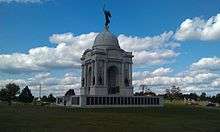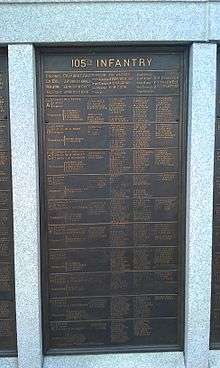105th Pennsylvania Infantry
| 105th Regiment Pennsylvania Volunteer Infantry | |
|---|---|
| Active | October 1861 to July 11, 1865 |
| Country | United States |
| Allegiance | Union |
| Branch | Infantry |
| Engagements |
Battle of Williamsburg Battle of Seven Pines Battle of Glendale Battle of Malvern Hill Battle of Chancellorsville Battle of Gettysburg Battle of the Wilderness Battle of Spotsylvania Court House First Battle of Deep Bottom |
The 105th Pennsylvania Volunteer Infantry, also known as the "Wildcat Regiment" was an infantry regiment that served in the Union Army during the American Civil War.
History
Organization and early battles
The 105th was raised mainly in the counties of Jefferson, Clarion, and Clearfield. It was organized at Pittsburgh in September and October 1861, and mustered into the U. S. service for a three-year term. Among the early recruits was future United States Congressman Albert C. Thompson.
The regiment was ordered to Washington in October and assigned to the 1st Brigade, 1st Division, III Corps, in Camp Jameson (on the farm of American Revolution patriot George Mason), near Alexandria.
Leaving camp on March 17, 1862, the regiment took part in the siege of Yorktown and the battles of Williamsburg and Fair Oaks. In the latter engagement, the troops fought like veterans, holding their position unsupported until nearly surrounded. Three companies were on special duty at the opening of the action and, being unable to reach the regiment in its exposed position, fought with the 57th Pennsylvania Infantry. After a month spent on picket duty, the 105th was again in action at Glendale and Malvern Hill, and, by the time it reached Harrison's Landing, the ranks were so reduced by wounds and sickness that less than 100 men were fit for active duty.
While posted along the railroad between Manassas and Warrenton Junction, companies B, G and H were captured by the Confederates. The 1st and Hooker's divisions were engaged at Bristoe Station on August 29. The following day, the entire army was in action at Second Bull Run, where once more the gallant work of the 105th resulted in significant losses. The regiment was specially complimented by Maj. Gen. Philip Kearny for its gallantry. September and October were spent at Washington. The command left the nation's capital on October 28, and, after some scouting near Leesburg, arrived at Falmouth on November 24. The 105th's next battle was at Fredericksburg, after which it spent the winter in camp near Brandy Station.
1863 and 1864 battles and campaigns
At the Battle of Chancellorsville in May 1863, the troops were warmly engaged, and many won the Kearny Medal of Honor (the Kearny Cross). The first two weeks of June were spent at Banks Ford, and then the troops started northward. At the Battle of Gettysburg, the regiment lost many men, and, after the return to Virginia, engagements followed at Auburn, Kelly's Ford, and Locust Grove in the Mine Run campaign late in November. At the end of that campaign, the regiment returned to the camp at Brandy Station for the winter, and, on December 28, 1863, nearly the entire regiment re-enlisted.
The regiment fought at the battles of the Wilderness and Spotsylvania in May 1864 and then moved to Petersburg with the army, where it took part in the operations of the X Corps in August and the movements upon the Wilmington and Weldon Railroad in October and December. On September 5, the remainder of the 63rd was added to the regiment.



The end of the war
On February 20, 1865, the 105th absorbed Company C of the 2nd United States Volunteer Sharpshooter Regiment, which as disbanded on that date, and in March 1865, about 300 new recruits were received. At Sailor's Creek, the 105th was actively engaged, after which it returned to Alexandria. It participated in the Grand Review of the Armies at Washington and was mustered out in that city on July 11, 1865.
Out of a total enrollment of 2,040, the regiment lost 309 men by death from wounds or disease, and 199 soldiers were reported as missing.
Senior officers
- Colonels
- Amor A. McKnight
- William W. Corbett
- Calvin A. Craig
- James Miller
- Lieutenant Colonels
- William W. Corbett
- Calvin A. Craig
- J. W. Greenawalt
- L. B. Duff
- Oliver C. Reddie
- Majors
- Mungo M. Dick
- J. W. Greenawalt
- Levi B. Duff
- John C. Conser
- James Miller
References
- Hogan, Edwin P., Waiting for Jacob: A Civil War Story, Latrobe, Pennsylvania: St. Vincent College, 2000. ISBN 1-885851-15-4.